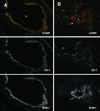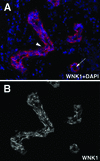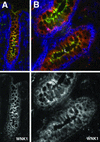WNK1, a kinase mutated in inherited hypertension with hyperkalemia, localizes to diverse Cl- -transporting epithelia
- PMID: 12522152
- PMCID: PMC141053
- DOI: 10.1073/pnas.242728499
WNK1, a kinase mutated in inherited hypertension with hyperkalemia, localizes to diverse Cl- -transporting epithelia
Abstract
Mutations in WNK1 and WNK4, genes encoding members of a novel family of serine-threonine kinases, have recently been shown to cause pseudohypoaldosteronism type II (PHAII), an autosomal dominant disorder featuring hypertension, hyperkalemia, and renal tubular acidosis. The localization of these kinases in the distal nephron and the Cl(-) dependence of these phenotypes suggest that these mutations increase renal Cl(-) reabsorption. Although WNK4 expression is limited to the kidney, WNK1 is expressed in many tissues. We have examined the distribution of WNK1 in these extrarenal tissues. Immunostaining using WNK1-specific antibodies demonstrated that WNK1 is not present in all cell types; rather, it is predominantly localized in polarized epithelia, including those lining the lumen of the hepatic biliary ducts, pancreatic ducts, epididymis, sweat ducts, colonic crypts, and gallbladder. WNK1 is also found in the basal layers of epidermis and throughout the esophageal epithelium. The subcellular localization of WNK1 varies among these epithelia. WNK1 is cytoplasmic in kidney, colon, gallbladder, sweat duct, skin, and esophagus; in contrast, it localizes to the lateral membrane in bile ducts, pancreatic ducts, and epididymis. These epithelia are all notable for their prominent role in Cl(-) flux. Moreover, these sites largely coincide with those involved in the pathology of cystic fibrosis, a disease characterized by deranged epithelial Cl(-) flux. Together with the known pathophysiology of PHAII, these findings suggest that WNK1 plays a general role in the regulation of epithelial Cl(-) flux, a finding that suggests the potential of new approaches to the selective modulation of these processes.
Figures








References
-
- Lifton R, Gharavi A, Geller D. Cell. 2001;4:545–556. - PubMed
-
- Wilson F, Disse-Nicodeme S, Choate K, Ishikawa K, Nelson-Williams C, Desitter I, Gunel M, Milford D, Lipkin G, Achard J, et al. Science. 2001;293:1107–1112. - PubMed
-
- Gordon R, Klemm S, Tunny T, Stowasser M. In: Hypertension: Pathophysiology, Diagnosis, and Management. Laragh B, Brenner M, editors. New York: Raven; 1995. pp. 2111–2123.
-
- Take C, Ikeda T, Kurasawa K, Kurokawa N. N Engl J Med. 1991;324:472–476. - PubMed
-
- Schambelan M, Sebastian F, Rector F., Jr Kidney Int. 1981;19:716–727. - PubMed
Publication types
MeSH terms
Substances
LinkOut - more resources
Full Text Sources
Medical
Molecular Biology Databases

